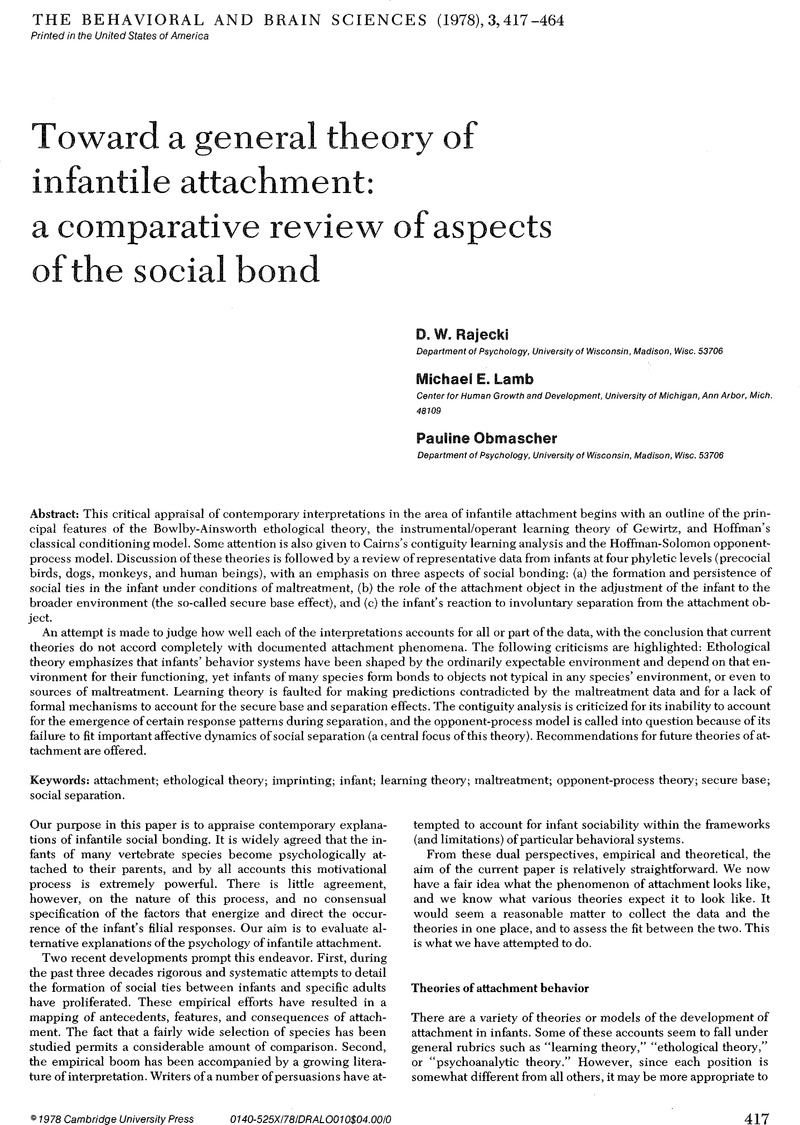No CrossRef data available.
Article contents
Interpretations, reinterpretations, and alleged misinterpretations of theory and data concerning attachment
Published online by Cambridge University Press: 04 February 2010
Abstract
An abstract is not available for this content so a preview has been provided. Please use the Get access link above for information on how to access this content.

- Type
- Author's Response
- Information
- Copyright
- Copyright © Cambridge University Press 1978
References
REFERENCES
Atz, J. W. The application of the idea of homology to behavior. In: Aronson, L. R., Tobach, E., Lehrman, D. S., & Rosenblatt, J. S. (eds.), Development and evolution of behavior. W. H. Freeman, San Francisco, 1970.Google Scholar
Coe, C. L., Mendotz, S. P., Smotherman, W. P., & Levine, S.Mother-infant attachment in the squirrel monkey: Adrenal response to separation. Behavioral Biology. 22:256–263, 1978.CrossRefGoogle ScholarPubMed
Eiserer, L. A. & Hoffman, H. S.Imprinting of ducklings to a second stimulus when a previously imprinted stimulus is occasionally presented. Animal Learning & Behavior. 2:123–125, 1974.CrossRefGoogle Scholar
Gewirtz, J. L. & Baer, D. M.Deprivation and satiation of social reinforcers as drive conditions. Journal of Abnormal and Social Psychology. 57:165–172, 1958.CrossRefGoogle ScholarPubMed
Harlow, H. F., Gluck, J. P., & Suomi, S. J.Generalization of behavioral data between nonhuman and human animals. American Psychologist. 27:709–716, 1972.CrossRefGoogle Scholar
Hodos, W. & Campbell, C. B. G.Scala Naturae: Why there is no theory in comparative psychology. Psychological Review. 76:337–350, 1969.CrossRefGoogle Scholar
Kaufman, I. C. & Stynes, A. J.Depression can be induced in a bonnet macaque infant. Psychosomatic Medicine. 40:71–75, 1978.CrossRefGoogle Scholar
Lockard, R. B.Reflections on the fall of comparative psychology: Is there a message for us all? American Psychologist. 26:168–179, 1971CrossRefGoogle Scholar
Lorenz, K. Z.Analogy as a source of knowledge. Science. 185:229–234, 1974.CrossRefGoogle ScholarPubMed
McBride, G., Parer, I., & Foenander, F.The social organization and behaviour of the feral domestic fowl. Animal Behaviour Monographs. 2:127–181, 1969.CrossRefGoogle Scholar
Rajecki, D. W., Ivins, B., & Rein, B.Social discrimination and aggressive pecking in domestic chicks. Journal of Comparative and Physiological Psychology. 90:442–452, 1976.CrossRefGoogle Scholar
Salzen, E. A. & Meyer, C. C.Imprinting: Reversal of a preference established during the critical period. Nature. 215:785–786, 1967.CrossRefGoogle ScholarPubMed
Washburn, S. L.Human behavior and the behavior of other animals. American Psychologist. 33:405–418, 1978.CrossRefGoogle Scholar
Zajonc, R. B., Wilson, W. R., & Rajecki, D. W.Affiliation and social discrimination produced by brief exposure in day-old domestic chicks. Animal Behaviour. 23:131–138, 1975.CrossRefGoogle ScholarPubMed


